Analysis of the Creation of Shared Value: Business Essay
VerifiedAdded on 2021/06/17
|6
|1420
|32
Essay
AI Summary
This essay provides an in-depth analysis of the concept of shared value, a business strategy introduced by Michael E. Porter, which links corporate social responsibility with competitive advantage. It contrasts shared value with traditional CSR, highlighting how shared value focuses on creating business opportunities by solving social problems. The essay discusses the three levels of shared value creation: reconceiving products and markets, redefining productivity in the value chain, and enabling local cluster development. It uses Nestle as a case study to illustrate the practical application of shared value, emphasizing the importance of stakeholder engagement and ethical principles. The conclusion underscores the need for modern organizations to adopt shared value to achieve sustainable operations and gain a competitive edge.
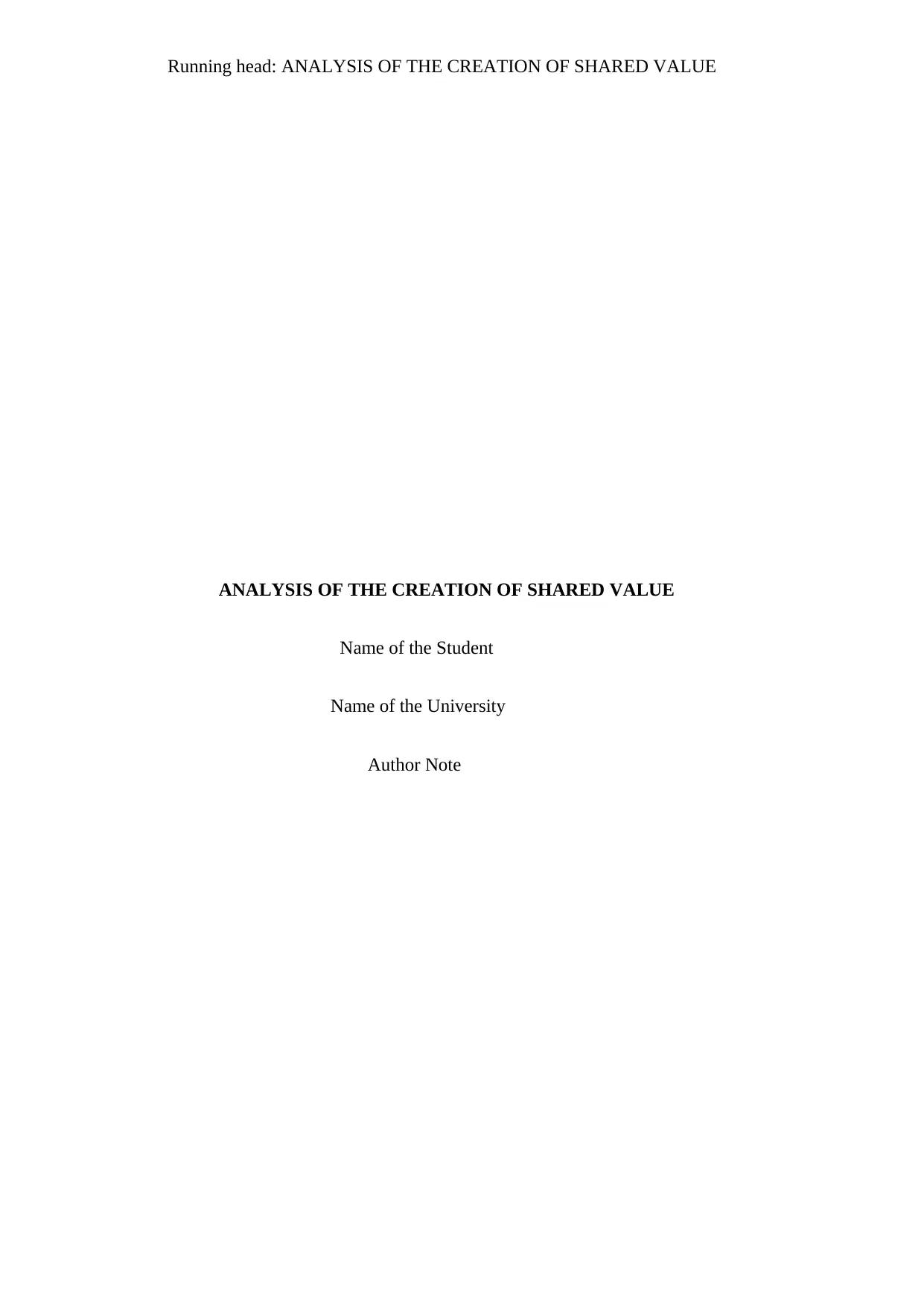
Running head: ANALYSIS OF THE CREATION OF SHARED VALUE
ANALYSIS OF THE CREATION OF SHARED VALUE
Name of the Student
Name of the University
Author Note
ANALYSIS OF THE CREATION OF SHARED VALUE
Name of the Student
Name of the University
Author Note
Paraphrase This Document
Need a fresh take? Get an instant paraphrase of this document with our AI Paraphraser
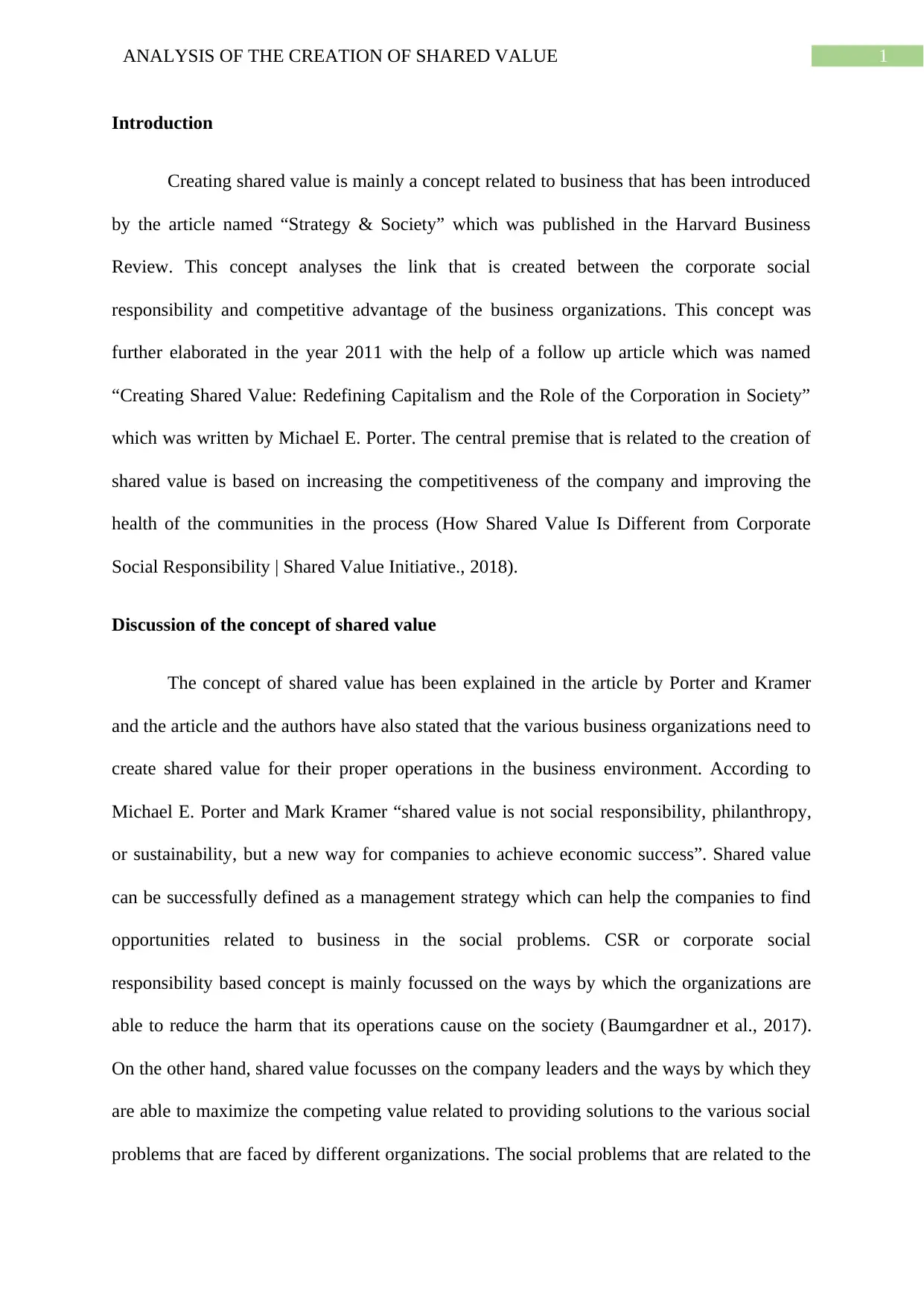
1ANALYSIS OF THE CREATION OF SHARED VALUE
Introduction
Creating shared value is mainly a concept related to business that has been introduced
by the article named “Strategy & Society” which was published in the Harvard Business
Review. This concept analyses the link that is created between the corporate social
responsibility and competitive advantage of the business organizations. This concept was
further elaborated in the year 2011 with the help of a follow up article which was named
“Creating Shared Value: Redefining Capitalism and the Role of the Corporation in Society”
which was written by Michael E. Porter. The central premise that is related to the creation of
shared value is based on increasing the competitiveness of the company and improving the
health of the communities in the process (How Shared Value Is Different from Corporate
Social Responsibility | Shared Value Initiative., 2018).
Discussion of the concept of shared value
The concept of shared value has been explained in the article by Porter and Kramer
and the article and the authors have also stated that the various business organizations need to
create shared value for their proper operations in the business environment. According to
Michael E. Porter and Mark Kramer “shared value is not social responsibility, philanthropy,
or sustainability, but a new way for companies to achieve economic success”. Shared value
can be successfully defined as a management strategy which can help the companies to find
opportunities related to business in the social problems. CSR or corporate social
responsibility based concept is mainly focussed on the ways by which the organizations are
able to reduce the harm that its operations cause on the society (Baumgardner et al., 2017).
On the other hand, shared value focusses on the company leaders and the ways by which they
are able to maximize the competing value related to providing solutions to the various social
problems that are faced by different organizations. The social problems that are related to the
Introduction
Creating shared value is mainly a concept related to business that has been introduced
by the article named “Strategy & Society” which was published in the Harvard Business
Review. This concept analyses the link that is created between the corporate social
responsibility and competitive advantage of the business organizations. This concept was
further elaborated in the year 2011 with the help of a follow up article which was named
“Creating Shared Value: Redefining Capitalism and the Role of the Corporation in Society”
which was written by Michael E. Porter. The central premise that is related to the creation of
shared value is based on increasing the competitiveness of the company and improving the
health of the communities in the process (How Shared Value Is Different from Corporate
Social Responsibility | Shared Value Initiative., 2018).
Discussion of the concept of shared value
The concept of shared value has been explained in the article by Porter and Kramer
and the article and the authors have also stated that the various business organizations need to
create shared value for their proper operations in the business environment. According to
Michael E. Porter and Mark Kramer “shared value is not social responsibility, philanthropy,
or sustainability, but a new way for companies to achieve economic success”. Shared value
can be successfully defined as a management strategy which can help the companies to find
opportunities related to business in the social problems. CSR or corporate social
responsibility based concept is mainly focussed on the ways by which the organizations are
able to reduce the harm that its operations cause on the society (Baumgardner et al., 2017).
On the other hand, shared value focusses on the company leaders and the ways by which they
are able to maximize the competing value related to providing solutions to the various social
problems that are faced by different organizations. The social problems that are related to the
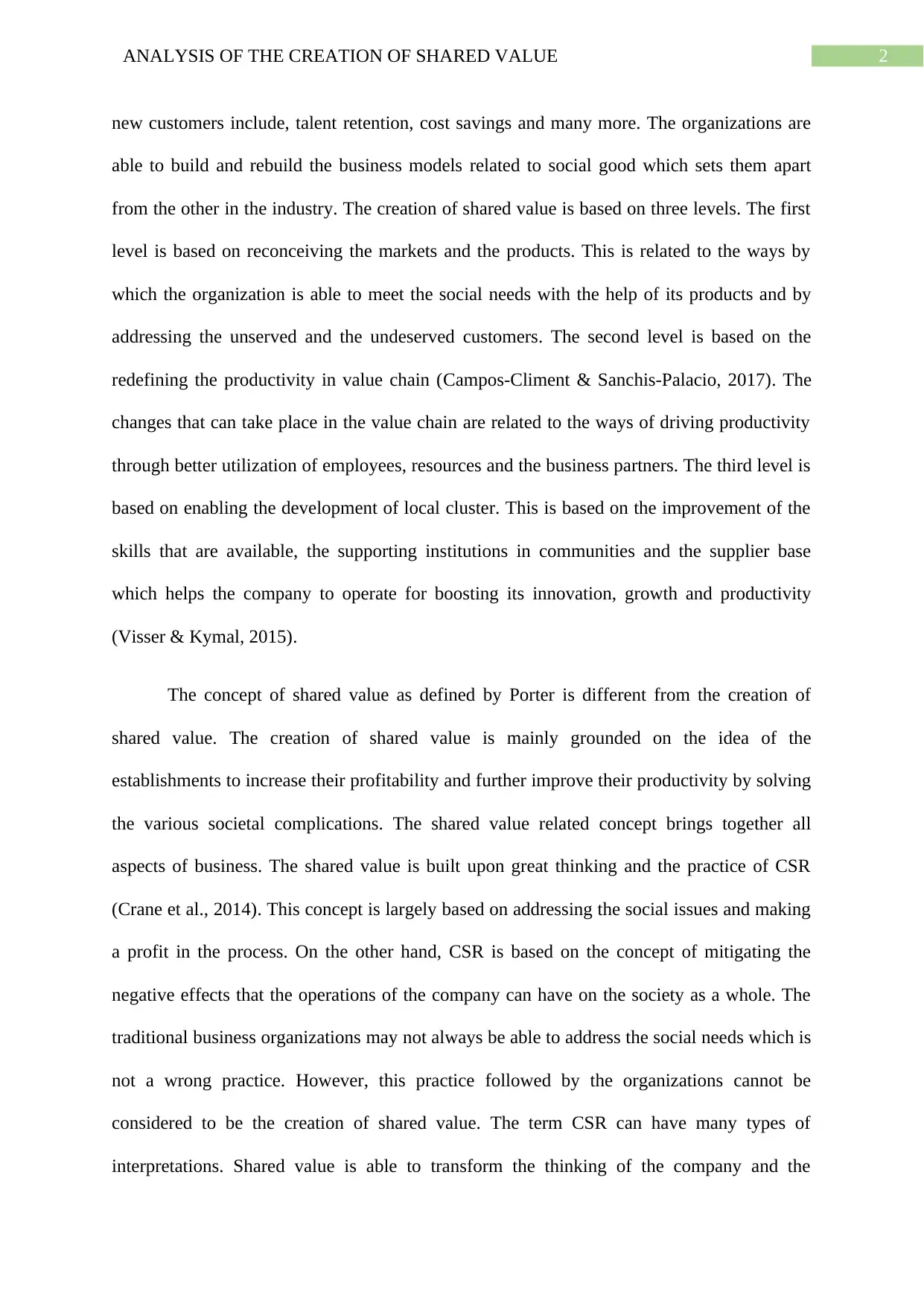
2ANALYSIS OF THE CREATION OF SHARED VALUE
new customers include, talent retention, cost savings and many more. The organizations are
able to build and rebuild the business models related to social good which sets them apart
from the other in the industry. The creation of shared value is based on three levels. The first
level is based on reconceiving the markets and the products. This is related to the ways by
which the organization is able to meet the social needs with the help of its products and by
addressing the unserved and the undeserved customers. The second level is based on the
redefining the productivity in value chain (Campos-Climent & Sanchis-Palacio, 2017). The
changes that can take place in the value chain are related to the ways of driving productivity
through better utilization of employees, resources and the business partners. The third level is
based on enabling the development of local cluster. This is based on the improvement of the
skills that are available, the supporting institutions in communities and the supplier base
which helps the company to operate for boosting its innovation, growth and productivity
(Visser & Kymal, 2015).
The concept of shared value as defined by Porter is different from the creation of
shared value. The creation of shared value is mainly grounded on the idea of the
establishments to increase their profitability and further improve their productivity by solving
the various societal complications. The shared value related concept brings together all
aspects of business. The shared value is built upon great thinking and the practice of CSR
(Crane et al., 2014). This concept is largely based on addressing the social issues and making
a profit in the process. On the other hand, CSR is based on the concept of mitigating the
negative effects that the operations of the company can have on the society as a whole. The
traditional business organizations may not always be able to address the social needs which is
not a wrong practice. However, this practice followed by the organizations cannot be
considered to be the creation of shared value. The term CSR can have many types of
interpretations. Shared value is able to transform the thinking of the company and the
new customers include, talent retention, cost savings and many more. The organizations are
able to build and rebuild the business models related to social good which sets them apart
from the other in the industry. The creation of shared value is based on three levels. The first
level is based on reconceiving the markets and the products. This is related to the ways by
which the organization is able to meet the social needs with the help of its products and by
addressing the unserved and the undeserved customers. The second level is based on the
redefining the productivity in value chain (Campos-Climent & Sanchis-Palacio, 2017). The
changes that can take place in the value chain are related to the ways of driving productivity
through better utilization of employees, resources and the business partners. The third level is
based on enabling the development of local cluster. This is based on the improvement of the
skills that are available, the supporting institutions in communities and the supplier base
which helps the company to operate for boosting its innovation, growth and productivity
(Visser & Kymal, 2015).
The concept of shared value as defined by Porter is different from the creation of
shared value. The creation of shared value is mainly grounded on the idea of the
establishments to increase their profitability and further improve their productivity by solving
the various societal complications. The shared value related concept brings together all
aspects of business. The shared value is built upon great thinking and the practice of CSR
(Crane et al., 2014). This concept is largely based on addressing the social issues and making
a profit in the process. On the other hand, CSR is based on the concept of mitigating the
negative effects that the operations of the company can have on the society as a whole. The
traditional business organizations may not always be able to address the social needs which is
not a wrong practice. However, this practice followed by the organizations cannot be
considered to be the creation of shared value. The term CSR can have many types of
interpretations. Shared value is able to transform the thinking of the company and the
⊘ This is a preview!⊘
Do you want full access?
Subscribe today to unlock all pages.

Trusted by 1+ million students worldwide
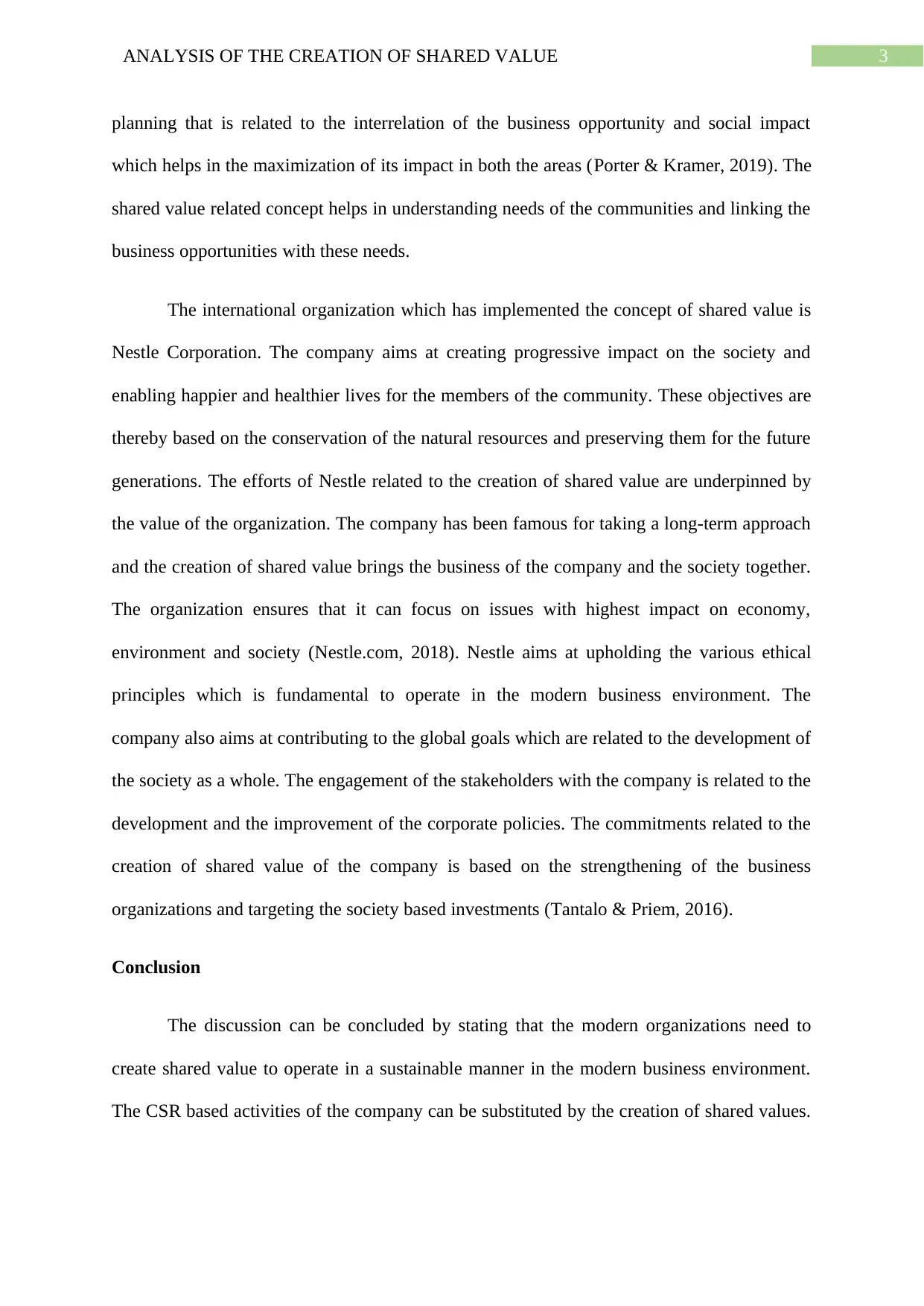
3ANALYSIS OF THE CREATION OF SHARED VALUE
planning that is related to the interrelation of the business opportunity and social impact
which helps in the maximization of its impact in both the areas (Porter & Kramer, 2019). The
shared value related concept helps in understanding needs of the communities and linking the
business opportunities with these needs.
The international organization which has implemented the concept of shared value is
Nestle Corporation. The company aims at creating progressive impact on the society and
enabling happier and healthier lives for the members of the community. These objectives are
thereby based on the conservation of the natural resources and preserving them for the future
generations. The efforts of Nestle related to the creation of shared value are underpinned by
the value of the organization. The company has been famous for taking a long-term approach
and the creation of shared value brings the business of the company and the society together.
The organization ensures that it can focus on issues with highest impact on economy,
environment and society (Nestle.com, 2018). Nestle aims at upholding the various ethical
principles which is fundamental to operate in the modern business environment. The
company also aims at contributing to the global goals which are related to the development of
the society as a whole. The engagement of the stakeholders with the company is related to the
development and the improvement of the corporate policies. The commitments related to the
creation of shared value of the company is based on the strengthening of the business
organizations and targeting the society based investments (Tantalo & Priem, 2016).
Conclusion
The discussion can be concluded by stating that the modern organizations need to
create shared value to operate in a sustainable manner in the modern business environment.
The CSR based activities of the company can be substituted by the creation of shared values.
planning that is related to the interrelation of the business opportunity and social impact
which helps in the maximization of its impact in both the areas (Porter & Kramer, 2019). The
shared value related concept helps in understanding needs of the communities and linking the
business opportunities with these needs.
The international organization which has implemented the concept of shared value is
Nestle Corporation. The company aims at creating progressive impact on the society and
enabling happier and healthier lives for the members of the community. These objectives are
thereby based on the conservation of the natural resources and preserving them for the future
generations. The efforts of Nestle related to the creation of shared value are underpinned by
the value of the organization. The company has been famous for taking a long-term approach
and the creation of shared value brings the business of the company and the society together.
The organization ensures that it can focus on issues with highest impact on economy,
environment and society (Nestle.com, 2018). Nestle aims at upholding the various ethical
principles which is fundamental to operate in the modern business environment. The
company also aims at contributing to the global goals which are related to the development of
the society as a whole. The engagement of the stakeholders with the company is related to the
development and the improvement of the corporate policies. The commitments related to the
creation of shared value of the company is based on the strengthening of the business
organizations and targeting the society based investments (Tantalo & Priem, 2016).
Conclusion
The discussion can be concluded by stating that the modern organizations need to
create shared value to operate in a sustainable manner in the modern business environment.
The CSR based activities of the company can be substituted by the creation of shared values.
Paraphrase This Document
Need a fresh take? Get an instant paraphrase of this document with our AI Paraphraser
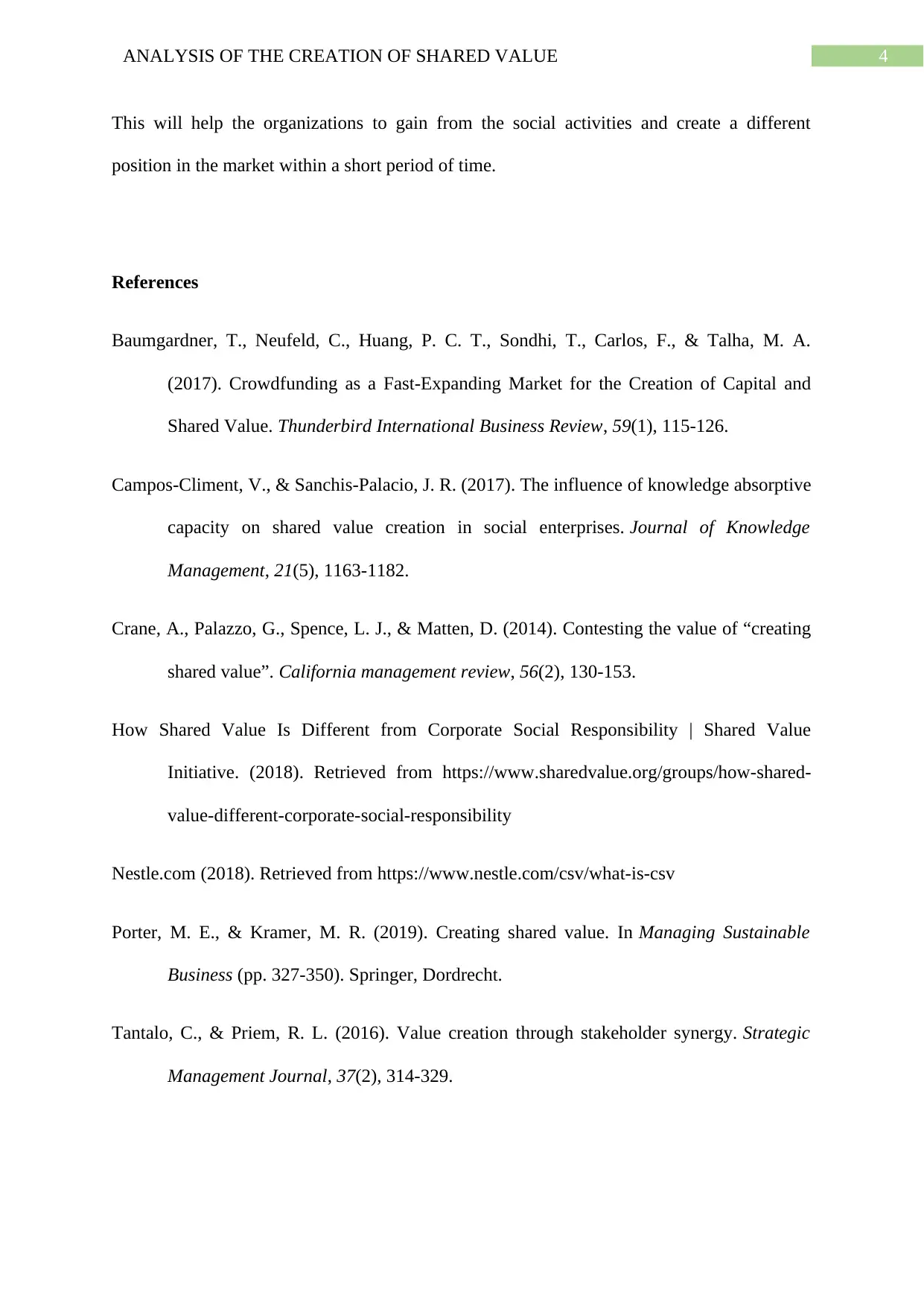
4ANALYSIS OF THE CREATION OF SHARED VALUE
This will help the organizations to gain from the social activities and create a different
position in the market within a short period of time.
References
Baumgardner, T., Neufeld, C., Huang, P. C. T., Sondhi, T., Carlos, F., & Talha, M. A.
(2017). Crowdfunding as a Fast‐Expanding Market for the Creation of Capital and
Shared Value. Thunderbird International Business Review, 59(1), 115-126.
Campos-Climent, V., & Sanchis-Palacio, J. R. (2017). The influence of knowledge absorptive
capacity on shared value creation in social enterprises. Journal of Knowledge
Management, 21(5), 1163-1182.
Crane, A., Palazzo, G., Spence, L. J., & Matten, D. (2014). Contesting the value of “creating
shared value”. California management review, 56(2), 130-153.
How Shared Value Is Different from Corporate Social Responsibility | Shared Value
Initiative. (2018). Retrieved from https://www.sharedvalue.org/groups/how-shared-
value-different-corporate-social-responsibility
Nestle.com (2018). Retrieved from https://www.nestle.com/csv/what-is-csv
Porter, M. E., & Kramer, M. R. (2019). Creating shared value. In Managing Sustainable
Business (pp. 327-350). Springer, Dordrecht.
Tantalo, C., & Priem, R. L. (2016). Value creation through stakeholder synergy. Strategic
Management Journal, 37(2), 314-329.
This will help the organizations to gain from the social activities and create a different
position in the market within a short period of time.
References
Baumgardner, T., Neufeld, C., Huang, P. C. T., Sondhi, T., Carlos, F., & Talha, M. A.
(2017). Crowdfunding as a Fast‐Expanding Market for the Creation of Capital and
Shared Value. Thunderbird International Business Review, 59(1), 115-126.
Campos-Climent, V., & Sanchis-Palacio, J. R. (2017). The influence of knowledge absorptive
capacity on shared value creation in social enterprises. Journal of Knowledge
Management, 21(5), 1163-1182.
Crane, A., Palazzo, G., Spence, L. J., & Matten, D. (2014). Contesting the value of “creating
shared value”. California management review, 56(2), 130-153.
How Shared Value Is Different from Corporate Social Responsibility | Shared Value
Initiative. (2018). Retrieved from https://www.sharedvalue.org/groups/how-shared-
value-different-corporate-social-responsibility
Nestle.com (2018). Retrieved from https://www.nestle.com/csv/what-is-csv
Porter, M. E., & Kramer, M. R. (2019). Creating shared value. In Managing Sustainable
Business (pp. 327-350). Springer, Dordrecht.
Tantalo, C., & Priem, R. L. (2016). Value creation through stakeholder synergy. Strategic
Management Journal, 37(2), 314-329.

5ANALYSIS OF THE CREATION OF SHARED VALUE
Visser, W., & Kymal, C. (2015). Integrated value creation (IVC): beyond corporate social
responsibility (CSR) and creating shared value (CSV). Journal of International
Business Ethics, 8(1), 29.
Visser, W., & Kymal, C. (2015). Integrated value creation (IVC): beyond corporate social
responsibility (CSR) and creating shared value (CSV). Journal of International
Business Ethics, 8(1), 29.
⊘ This is a preview!⊘
Do you want full access?
Subscribe today to unlock all pages.

Trusted by 1+ million students worldwide
1 out of 6
Related Documents
Your All-in-One AI-Powered Toolkit for Academic Success.
+13062052269
info@desklib.com
Available 24*7 on WhatsApp / Email
![[object Object]](/_next/static/media/star-bottom.7253800d.svg)
Unlock your academic potential
Copyright © 2020–2025 A2Z Services. All Rights Reserved. Developed and managed by ZUCOL.





